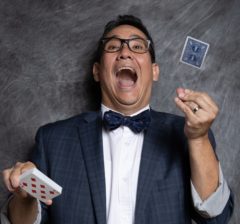After starting to read the book Principia by Harapn Ong about a year ago, I finally finished it. It’s a book that I’d read a bit of it, then put it down and pick it back up a month later. It’s a great book, and there are a couple things in it that I’ve used throughout the year.

Near the end of the book there are a couple of essay’s on the Trick That Cannot Be Explained. These are fantastic! There’s some great theory in them, not just on the card trick, but on tricks using multiple outs.
Also near the end, there’s a trick where the cards get mixed face up and face down. You find their selected card, and no the cards don’t all magically fix themselves. The cards not fixing themselves is what I think makes this trick great, and something that I think is going to go into my impromptu card magic toolbox.
If you do card magic, check out this book!





